Latitude: 61 59.70Longitude: 17 618.76
"I really like that ice but if I can't have that then how about over there, before the ridge?" Katrin Iken, polar marine biologist from the University of Alaska Fairbanks, was on the Bridge at sunrise looking for ice. Katrin's criteria for ice hunting is a nice flat surface for working, thick enough to support us but not too thick for drilling the ice cores that she needs to conduct her research. By 10am we were suited up in our MSD900s and kneeling on a patch that was "just right."
Taking leave from the "mud team", I have temporarily joined Dr. Iken's team of Arctic ecologists. As a group, they are working to gather samples and make observations that will help them to better understand the ecosystem here as a whole. Her primary research interests involve understanding the connections between the organisms in the various trophic, or energy, levels. She is trying to make scientific connections between the organisms to create a complete picture of how they interact with each other, constructing a food web. She learns about the resident organisms in the Bering Sea home by gathering samples in many different ways. From the surface producers to the benthic consumers, Katrin wants to find the answer to the ecological question "Who Eats Who?"
Katrin's team is seemingly everywhere at all times but today they were on the ice. I was there with them. We were busy. First things first, drill some holes. You've seen this before.
 Katrin and Pat use the auger to drill into the ice. They are surprised when they hit seawater rather quickly!
Katrin and Pat use the auger to drill into the ice. They are surprised when they hit seawater rather quickly!
Three holes in the ice served as stations for gathering three different kinds of samples.
Station One: The Dunk Tank
Here is a video of me taking water samples with the water-sampler. First, you open the top and bottom doors of the chamber. Then, you lower the bottle into the hole in the ice. After lowering it 5 meters under the ice, you send down a weight that releases the doors, trapping the water sample inside. Finally, you pull it up. You've got water! Five casts later you have enough water to work with. Back in the lab, changes in the water will be monitored for the presence of chlorophyll. Some samples will be analyzed for what kinds of microscopic organisms are living in there.
http://
Station Two:
Video GamesJared set to work getting video of life under the ice. By placing a camera in one spot and then leaving it for an hour he is able to record what goes on when no one is messing about under the ice with nets and bottles. This way the organisms come to him. The team can take a look to see what feeds on the ice algae and what else goes on in this well-lit zone. Hopefully he caught some krill on tape!
 Jared Weems, a student at the University of Alaska in Fairbanks, carfeully sets up his video recorder that he will send under the ice. He uses the images to identify organisms living in the water underneath.
Jared Weems, a student at the University of Alaska in Fairbanks, carfeully sets up his video recorder that he will send under the ice. He uses the images to identify organisms living in the water underneath.
Station Three: Sediment Sensation
Meanwhile, Katrin and Patrick were using some major muscle to lower sediment traps into the water. These traps were to stay on the ice for 5 hours, collecting samples long after we were finished. The objective of these drops is to collect particles falling out of the water column. Looking at the bodies of animals that fall down as well as their fecal pellets (poop) can tell the biologists a lot about how these animals act while they are alive.
 Patrick Kelly and Katrin Iken prepare sediment traps from sending down through one of the holes in the ice. They return five hours later to collect them.
Patrick Kelly and Katrin Iken prepare sediment traps from sending down through one of the holes in the ice. They return five hours later to collect them.
Once the work at the stations was complete, there was more drilling to be done. This time, the goal was to extract a core that could be kept rather than just get through the ice.
 Jared Weems operates the corer. The chamber will cut a cylinder that can then be used for sampling.
Jared Weems operates the corer. The chamber will cut a cylinder that can then be used for sampling.
Ice cores can reveal all sorts of information about the environment. Locking up information about climate, organisms and atmospheric conditions, these cores are an essential piece of the ecology team's research. Once we had cores, we set about making holes in them and slicing them up. The holes were for taking the temperature of the cores.
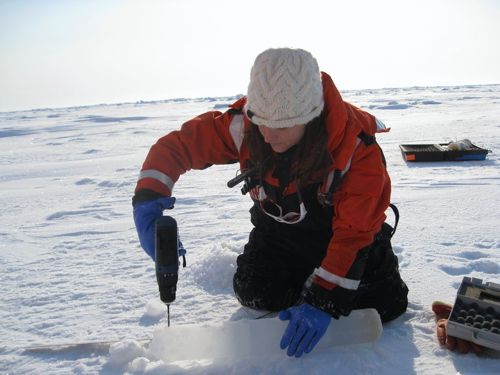 Under the supervision of Heloise Chenelot, I am drilling holes every few centimeters. These holes are used to insert a thermometer to take the temperature of the ice.
Under the supervision of Heloise Chenelot, I am drilling holes every few centimeters. These holes are used to insert a thermometer to take the temperature of the ice.
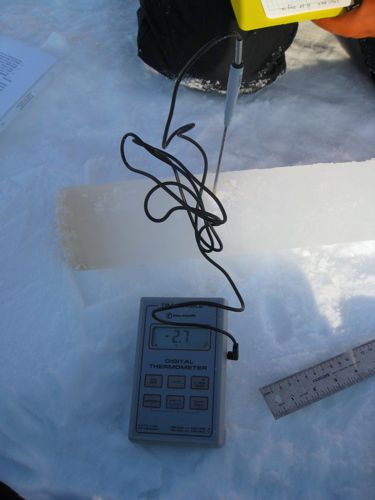 Ice temperatures are recorded at various levels on the cores. As the testing spot moves towards the surface, the ice gets colder. This reveals the warming oower of the water in a harsh climate.
Ice temperatures are recorded at various levels on the cores. As the testing spot moves towards the surface, the ice gets colder. This reveals the warming oower of the water in a harsh climate.
Are these cores sick? No about -6º C to 2º C , these cores show how temperature changes throughout the layers from seawater to surface. Surface temperatures are much colder, as the seawater keeps the lower layers warm. The temperature conditions at each level affect what kinds of organisms exist in each.
Temperatures recorded, we then began slicing cores. Each slice had to be carefully put in a Ziploc bag that was labeled with the origin on the core.
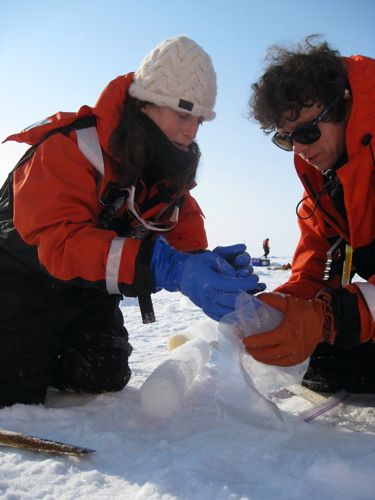 By slicing the cores at predetermined intervals, levels of ice can be studied in isolation back in the lab. Each segment is transported in a Ziploc that is carefully labeled to indicate its origin on the core.
By slicing the cores at predetermined intervals, levels of ice can be studied in isolation back in the lab. Each segment is transported in a Ziploc that is carefully labeled to indicate its origin on the core.
Check out the video of me slicing a core into samples sections that are headed back to the lab. Once inside, the team will begin melting the pieces to conduct tests on what organic material can be found inside.
http://
All work and no play would make for a dull science team and crew so the afternoon meant "Ice Liberty" for anyone who wanted to head out to the ice to play. Once the sleds of equipment had been safely stowed, the kickball came out- well, sort, of. Playing kickball is much more challenging in steel-toed rubber boots, a mustang suit and lots of snow. With a "bear watch" and a rescue swimmer on watch, this was no ordinary game.
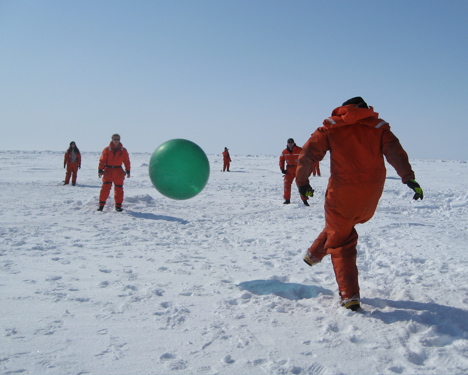 Well, sort of. The ball was bigger, the players were clumsier and the bases were snowmounds but kickball it was!
Well, sort of. The ball was bigger, the players were clumsier and the bases were snowmounds but kickball it was!
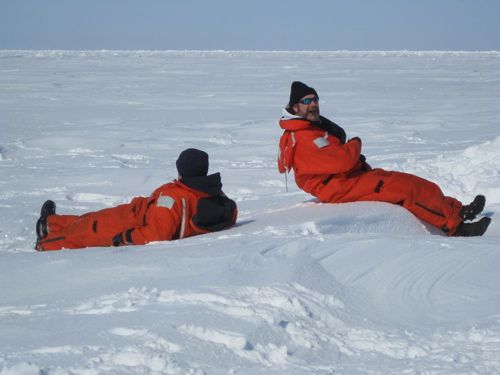 Coasties and scientists took to the ice to relax and and soak up the sunshine. Boy, was it bright out there!
Coasties and scientists took to the ice to relax and and soak up the sunshine. Boy, was it bright out there!
We ended in a tie and headed to the Mess Hall for dinner.
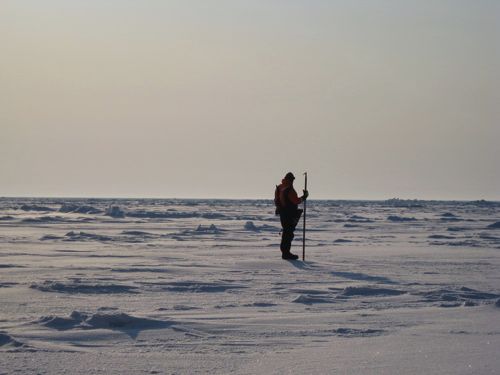 The lone bear watch stands guard while scientists work in the morning and everyone plays in the afternoon. He is constantly scanning the horizon for an unwelcome vistors that might want to break up the game!
The lone bear watch stands guard while scientists work in the morning and everyone plays in the afternoon. He is constantly scanning the horizon for an unwelcome vistors that might want to break up the game!
Adventures from behind the scenes in the Mess Hall tomorrow. Stay tuned...

